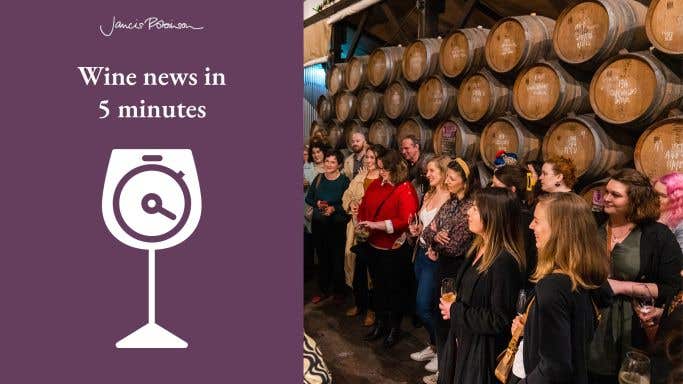Sam reports the news from Napa, where she’s tasting 2021 Napa Valley Cabernet Sauvignon for a report she and Jancis will file soon. Above, the launch of Women and Revolution, an Australian organisation she details below.
Drink Writer of the Year? Perhaps …
Before I launch into world news, I want to give a shout out to Tam Currin. Tam started writing for JancisRobinson.com in 2008. She’s a superb writer and an even better human being and our team is so lucky to have her. On 9 April we found out that she has been shortlisted for the Fortnum & Mason Food and Drink Awards’ Drink Writer of the Year for her coverage of Armenia’s wines and wine culture. If you haven’t read it yet, please do. We will find out who the finalists are on 2 May.
Women in wine
On Monday we ran Australian Women and Revolution, in which Max Allen, our Australian specialist, highlights Women and Revolution (WaR), an organisation which is seeking to dismantle gender bias and fight for equal representation and treatment in the wine industry. This follows on Jancis having written A better deal for women?, in which she cites a survey done in the UK that showed that 78% of women in the wine industry feel that sexism, gender bias and harassment are issues and 44% have considered leaving the trade because of it. In an attempt to bring more awareness to the women in this industry and encourage drinkers to support them, WaR has started a database of female winemakers, viticulturists, brewers and distillers. The database serves to connect these women as well as allowing drinkers to find women-owned brands. You can go check it out or add to it on the Women and Revolution site.
As an aside, there is also an extreme shortage of women in wine represented on Wikipedia. If you’ve ever considered being a volunteer editor for Wikipedia or if you already are a volunteer editor, it would be wonderful if you’d consider adding notable female figures in the wine industry.
British Columbia's challenges (and a plea to drink local)
If you’ve been following along with this broadcast, you know that British Columbia has been having a hard go of it. In my newscast on 20 February I discussed the recent frost that wiped out an expected 95–98% of BC’s wine-grape crop. The 2023 vintage was also hard hit by a freeze, and wine tourists were barred from travel during the 2023 wildfires. In 2021, the province experienced a heat dome and fires which were then followed by floods in the early winter. In 2020, fires.
This is all background for explaining that the region has experienced extreme pressure on multiple fronts, and the expected tiny 2024 vintage isn’t going to alleviate that. But what’s happening in the industry right now, quite separate from climate threats, may determine if any small local wineries survive in British Columbia. Right now, bulk international wine, bottled by large commercial companies, is looking to take the market for BC-grown wine. Let me give some context.
In British Columbia there are two types of licenced wineries: ‘land-based wineries’ or LBWs, which make and bottle wine entirely from BC-grown grapes. And there are commercial licence wineries that can make both BC wines as well as wines blended from imported wine. Larger commercial wineries sell a lot of imported wine under the designation ‘international blend from imported and domestic wines’, which in BC requires only 1% of domestic wine in the mix. And clearly these wineries are not suffering the same fate as 100% BC wines – because they can easily buy up grapes from Washington or anywhere else with a grape glut and go on with business as usual.
Because it’s always been easier for these wineries to operate during poor vintages and because BC does like to protect its local industry, historically, the organisation Wine Growers of British Columbia (WGBC) has protected local producers by entering into licensing agreements with grocery chains whereby only BC-grown wines are stocked in grocery stores. If you want cheaper international wines or blended wines, you can find them in liquor stores.
But with current wine shortages and high prices, Pattison Food Group (PFG), who owns the Save on Foods grocery stores, decided to go against their licensing agreement in early March and stocked blended wines sold to them by Andrew Peller Limited, one of the largest commercial wineries. WGBC initially released a statement condemning the decision but has since released a statement saying they have reached an agreement with PFG whereby PFG is allowed to stock a limited amount of blended wine. It remains to be seen if other grocery chains will follow.
If you’re thinking that this is just life, and consumers should be able to purchase cheap wine – that’s fair enough. But the fact is that a lot of wine in both Canada and the US is masquerading as a Canadian or American wine and is in fact imported bulk wine. (Read about Stuart Spencer’s recent report on US brands bottling imported bulk wine.) If you’re in these markets, please be aware of what you’re buying, because large commercial wine brands are doing their best to keep you in the dark. If you’d like to help local wineries, look for a BC VQA (Vintners Quality Alliance) label, read the back of your US wine bottles, and buy direct from a winery you know and love and you want to keep around. Honestly, that’s just good advice for anywhere!
This is a transcript of our weekly five-minute news broadcast, which you can watch below. You can also listen to it on The JancisRobinson.com Podcast. If you have breaking news in your area, please email news@jancisrobinson.com. And if you enjoy this content and would like to see more like it, please subscribe to our site and our weekly newsletter.
Photo at top by Dexter Kim.

